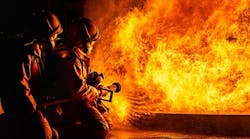The plant floor at the West Pharmaceuticals facility in Kingston, N.C., was kept spotless to meet hygiene requirements. However, combustible polyethylene dust accumulated in the suspended ceiling. This led to a dust explosion on January 29, 2003, that killed six workers, injured 38, and destroyed the plant. The U.S. Chemical Safety and Hazard Investigation Board (CSB) couldn’t identify the ignition source.
As I noted in last month’s column “Get Fired Up About Combustible Dust,” the CSB blames dust explosions for numerous fatalities at many plants. That column provided some basic information on what constitutes a combustible dust. Here, we’ll get into how to identify the risks of dust fires and explosions.
Many plants face risks of dust explosions. Indeed, according to G. Vijayaraghavan, more than 70% of the powders handled by industry are combustible and a vast majority of plants with powder-processing equipment are susceptible to dust explosions (“Emerging Emergencies Due to Dust Explosions in Process Industry,” J. of Eng. Res. and Studies, Vol. II, 2011).
Checking material safety data sheets (MSDSs) isn’t the way to identify risks. Unfortunately, many MSDSs lack necessary details; the MSDS for polyethylene didn’t warn the people at West Pharmaceuticals about possible combustion of dried dust. Indeed, the CSB found that 41% of MSDS forms don’t mention risk of combustible dust.
There are many risks to consider and they are highly situational. Studies in the United States show that 42% of explosions occur in dust collection systems; 9% in grinding and pulverizing; 9% in conveyors (e.g., screw conveyors); 7% in silos; 6% in dryers and ovens; less than 3% in mixing operations; and a stunning 23% from unknown sources. Oddly, these percentages differ markedly in other countries: the U.K. reports only 18% of explosions arise in dust collection while Germany cites 17%. Still, dust collection appears to be one of the most dangerous activities in handling powders.
I am surprised by the lower risk in grinding and drying. These activities seem to epitomize high risk; they can be deadly — an engineer I knew died during a fire at an ammonium perchlorate grinding facility in Nevada. My pet theory is that because these processes are extremely dangerous, companies and workers are especially cautious in their operation.
Identifying the actual causes of explosions instead of taking the easy way out by simply labeling them “unknown” clearly demands far greater emphasis. Of course, pinning down the culprit can be hard. Sometimes several factors that weren’t adequately considered conspire to cause an explosion.
Let’s consider what triggers a primary dust explosion. According to one study: 11% stem from welding/cutting; 9% from friction; 8% from fire; 5% from static electricity; 4% from an electrical short; and 3% from lightning. “Unknown” accounts for a whopping 60%. Obviously, there’s more work to be done here!
One thing you won’t find discussed much is how particle properties affect risks in handling dust and particles. The National Fire Protection Association, Quincy, Mass., has established >420 µ as a relatively safe powder diameter; read the fine print — test. Also, it notes that generally >1/32nd of an inch of dust over more than 5% of room area poses a combustion risk.
The real risk is particle distribution: more than 10% fines is enough to ignite the rest. When I was doing research on rockets in the U.S. Air Force, we studied the relationship among fine, medium and coarse oxidizers, like ammonium perchlorate. There is an optimum balance of sizes needed to promote combustion. So, in this case, our safety analysis didn’t focus on the mean particle size or shape but instead on the weighted average distribution.
Another factor is friability, i.e., can coarse particles be ground easily into fine ones. Then, there is shape, defined by aspect ratio (small diameter/large diameter); long particles rub together and stick, so they don’t flow well — making them move creates friction and breaks them up into fine particles.
Surface porosity is important. If a powder is hydroscopic, water can get in pores and dissolve material that may recrystallize somewhere else, perhaps in a much finer, lethal form. Porosity poses another risk: a powder may absorb a flammable vapor creating a hybrid hazard that is far more dangerous than either the vapor or solid alone.



